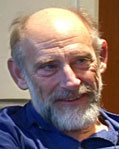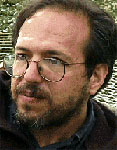July 26, 2004
Smolin's publication of "Scientific alternatives to the anthropic principle" and his summary of the arguments, written at Susskind's request.
Dear Lenny,
Thanks. Glad to. I'll start with one of the main arguments I make.
I show that the argument of Weinberg and others [Garriga and Vilenkin] are incorrect. The subtle point is that their arguments have embedded in them correct arguments having to do only with what we observe. To an already correct argument is then added mention of the anthropic principle. As it is added to an already correct argument, the anthropic principle plays no role in the actual scientific argument.
Here is how it goes: We start with a theory of structure formation that tells us
"Too large positive Lambda interferes with galaxy formation.
We do observe that galaxies have formed. Therefore we predict that the cosmological constant could not have been too large.
This is correct reasoning, and it agrees with observation.
What Weinberg and others have done is to make the error of embedding this argument into one that first mentions some version of the antrhopic principle. The mistake is not to notice that because it has been added to an argument that is already correct, the mention of the anthropic principle [or the principle of mediocrity, or life] plays absolutely no role in the argument.
The logic of their arguments is
A implies B B is observed B, together with theory C implies D.
Here
A is any form of the Anthropic Principle of Principle of Mediocrity, together with assumptions about priors, proabability distrbutions on universes etc, plus our own existence, that leads to the conclusion that we should observe B.
B is that galaxies have formed.
C is the theory of structure formation,
D is that the cosmological constant is not too large.
The fallacy is not to recognize that the first line plays no role in the argument, and the prediction of D is equally strong if it is dropped. One can prove this by noting that if D were not seen, one would have to question the theory C [assuming the observation is correct, as it certainly is here.] One would have no reason to question either A or the assertion that A implies B.
This is the same fallacy involved in Hoyle's argument about carbon. He reasoned simply from an observation that carbon is plentiful in our universe to a prediction that, as it must have been formed in stars, there must be a resonance at a particular energy. This was correct and the resonance was observed. But he fallaciously attributed the argument to the existence of life, which was a non-sequitor.
In the paper I show that every use of the anthropic principle claimed in physics and cosmology is either an example of this fallacy, or is so vague that one can get any conclusion one wants, and match any observation, by manipulating the assumptions made.
I then go on to explain what a multiverse theory would have to do to yield genuine falsifiable predictions that actually depend on the existence of the multiverse. I give conditions for this to work. I then show that there exist real theories that satisfy these conditions, one of them being my old natural selection idea.
Therefore, the anthropic principle cannot help us to do science. But there are ways to do science if we are faced with a multiverse.
Lee




